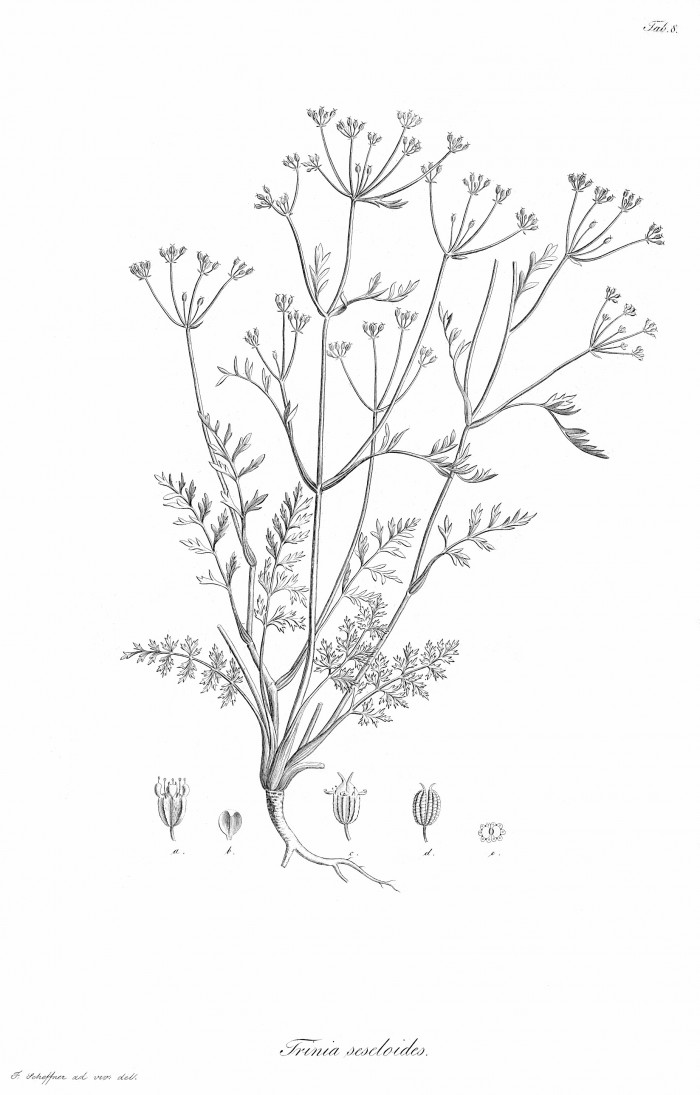Saposhnikovia divaricata (Turcz.) Schischk. - syn. Ledebouriella divaricata (Turczaninow) M. Hiroe; Apiaceae
fang feng 防風 (chin.), Saposhnikovia
Plant up to 80cm tall, native to North East Asia (Siberia, Korea, China); rootstock to 2cm thick; leaves 2-pinnate; pinnae 3-4 pairs, leaflets oblong-ovate to broad-ovate, ultimate segments linear-lanceolate or cuneate-obovate; umbels numerous, ca. 6cm across, umbellules 4-5-flowered, petals ca. 1.5mm; fruits 4-5 × 2-3 mm. The root is used as the important traditional Chinese medicine “fang feng.” http://www.efloras.org/florataxon.aspx?flora_id=2&taxon_id=200015899
The dried roots of S. divaricata are used for the treatment of rheumatism, headache, convulsion and nerve
paralysis in traditional medicine of China and Korea.
[Bae, K. H., The Medicinal Plants of Korea; Kyo-Hak: Seoul, 2000; 380]
Panaxynol (falcarinol) was found to be the main constituent of the essential oil from the root of S.divaricata.
[GC-MS Analysis of the essential oil from the root of Saposhnikovia divaricata (Turcz.) Schischk., Li, Ji, Xu Zhiling, and Pan Jiongguang., Natural Product Research and Development 4, 1995, 1]
„The roots of Saposhnikovia divaricata Schischk. (Umbelliferae) have been known to possess analgesic, anti-inflammatory, anti-parasitic and anti-bacterial activities, and used for curing headaches, fever and arthralgia. In this study, we aimed to isolate active constituents to provide phytochemical data for the quality control of this plant. Nine coumarins, eight chromones, three sterols and a coumarolignan were isolated from EtOAc-soluble fraction of the roots of S. divaricata through repetive column chromatography method using silica gel, ODS gel, Sephadex-LH 20, MPLC and HPLC. By analyses of spectroscopic data and comparison of their data with those of published values, the compounds were identified as 3'-O-angeloylhamaudol (1), β-sitosterol (2), marmesin (3), phellopterin (4), anomalin (5), imperatorin (6), xanthotoxin (7), deltoin (8), bergapten (9), stigmasterol (10), ledebouriellol (11), hamaudol (12), 8'-epicleomiscosin A (13), xanthoarnol (14), cimifugin (15), 5-O-methylvisamminol (16), daucosterol (17), 4'-O-β-D-glucosyl-5-O-methylvisamminol (18), nodakenin (19), sec-O-glucosylhamaudol (20), prim-O-glucosylcimifugin (21). Among them, 8'-epicleomiscosin (13) was firstly reported from Umbelliferae family and xanthoarnol (14) and nodakenin (19) were isolated from this plant for the first time.“
[Chemical constituents of Saposhnikovia divaricata. Kim, S. J., et al., Korean Journal of Pharmacognosy,2008]
„Anomalin, a pyranocoumarin constituent of S. divaricata, exhibits potent anti-inflammatory activity… several pro-inflammatory cytokines, including tumor necrosis factor-α (TNF-α) and interleukin-6 (IL-6), were reduced by anomalin, and this reduction correlated with the down-regulation of the NF-κB signaling pathway. In addition, anomalin suppressed the LPS-induced phosphorylation and degradation of IκBα… LPS-induced NF-κB DNA binding was drastically abolished by anomalin. The present data suggest that anomalin is a major anti-inflammatory agent and may be a potential therapeutic candidate for the treatment of inflammatory disorders.“
[Suppression of LPS‐induced inflammatory and NF‐κB responses by anomalin in RAW 264.7 macrophages. Khan, Salman, et al., Journal of cellular biochemistry, Vol.112(8), 2011, 2179-2188]

S.divaricata as Trinia seseloides (Hoffm.) Ledeb.; Ledebour, C.F. von, Icones plantarum novarum, vol.1 t.8 (1829)
http://plantgenera.org/species.php?id_species=906045
